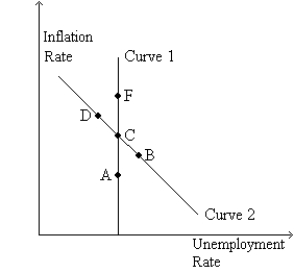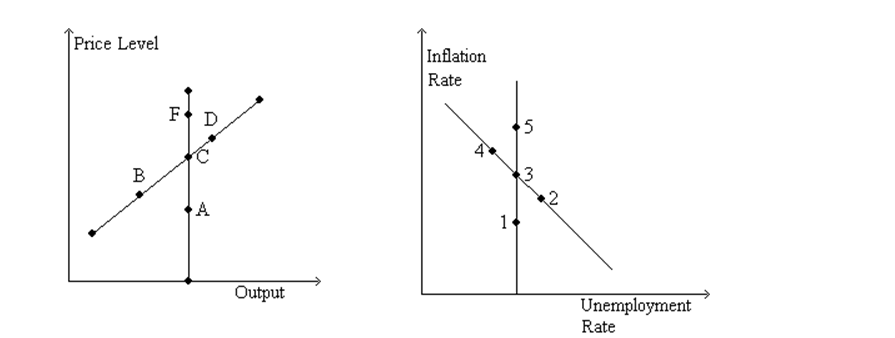A) the natural rate of unemployment rises.
B) the natural rate of unemployment falls.
C) the unemployment rate will be above its natural rate.
D) the unemployment rate will be below its natural rate.
F) None of the above
Correct Answer

verified
Correct Answer
verified
Multiple Choice
In the long run an increase in the money supply growth rate affects
A) the inflation rate and the natural rate of unemployment.
B) the inflation rate,but not the natural rate of unemployment.
C) neither the inflation rate nor the natural rate of unemployment.
D) the natural rate of unemployment,but not the inflation rate.
F) All of the above
Correct Answer

verified
Correct Answer
verified
Multiple Choice
Figure 35-6
Use the graph below to answer the following questions.  -Refer to Figure 35-6.If the economy starts at C and the money supply growth rate decreases,in the short run the economy moves to
-Refer to Figure 35-6.If the economy starts at C and the money supply growth rate decreases,in the short run the economy moves to
A) B.
B) C.
C) F.
D) None of the above is consistent with a decrease in the money supply growth rate.
F) B) and C)
Correct Answer

verified
Correct Answer
verified
Multiple Choice
A policy that raised the natural rate of unemployment would shift
A) both the short-run and the long-run Phillips curves to the right.
B) the short-run Phillips curve right but leave the long-run Phillips curve unchanged.
C) the long-run Phillips curve right but leave the short-run Phillips curve unchanged.
D) neither the long-run Phillips curve nor the short-run Phillips curve right.
F) B) and D)
Correct Answer

verified
Correct Answer
verified
Multiple Choice
According to Friedman and Phelps's analysis of the Phillips curve,
A) the unemployment rate will be below its natural rate whenever inflation is negative.
B) the unemployment rate will be below its natural rate whenever inflation is positive.
C) the unemployment rate will be below its natural rate only if inflation is less than expected.
D) the unemployment rate will be below its natural rate only if inflation is greater than expected.
F) None of the above
Correct Answer

verified
Correct Answer
verified
Multiple Choice
According to Friedman and Phelps,the unemployment rate
A) is never below its natural rate.
B) is below its natural rate when actual inflation is greater than expected inflation.
C) is below its natural rate when actual inflation is less than expected inflation.
D) is below its natural rate when actual inflation equals expected inflation.
F) A) and C)
Correct Answer

verified
Correct Answer
verified
Multiple Choice
Which of the following is vertical?
A) both the long-run Phillips curve and the long-run aggregate supply curve
B) neither the long-run Phillips curve nor the long-run aggregate supply curve
C) the long-run Phillips curve,but not the long-run aggregate supply curve
D) the long-run Phillips curve,but not the long-run aggregate supply curve.
F) A) and B)
Correct Answer

verified
Correct Answer
verified
Multiple Choice
If unemployment is above its natural rate,what happens to move the economy to long-run equilibrium?
A) Inflation expectations rise which shifts the short-run Phillips curve to the right.
B) Inflation expectations rise which shifts the short-run Phillips curve to the left.
C) Inflation expectations fall which shifts the short-run Phillips curve to the right.
D) Inflation expectations fall which shifts the short-run Phillips curve to the left.
F) A) and C)
Correct Answer

verified
Correct Answer
verified
Multiple Choice
By about 1973,U.S.policymakers had learned that
A) there is no trade-off between inflation and unemployment in the short run.
B) there is no trade-off between inflation and unemployment in the long run.
C) Friedman's analysis of inflation and unemployment had been correct,and Phelps's analysis of inflation and unemployment had been incorrect.
D) Phelps's analysis of inflation and unemployment had been correct,and Friedman's analysis of inflation and unemployment had been incorrect.
F) C) and D)
Correct Answer

verified
Correct Answer
verified
Multiple Choice
The idea that the long-run Phillips curve is
A) vertical stems from the analysis of Samuelson and Solow.
B) vertical stems from the analysis of Friedman and Phelps.
C) vertical was disproved by the experiment that monetary and fiscal policymakers inadvertently created in the 1970s.
D) downward-sloping can be correct if unemployment responds very quickly to unexpected inflation.
F) A) and C)
Correct Answer

verified
Correct Answer
verified
Multiple Choice
Figure 35-6
Use the graph below to answer the following questions.  -Refer to Figure 35-6.Curve 1 is the
-Refer to Figure 35-6.Curve 1 is the
A) long-run aggregate supply curve.
B) short-run aggregate supply curve.
C) long-run Phillips curve.
D) short-run Phillips curve.
F) A) and B)
Correct Answer

verified
Correct Answer
verified
Multiple Choice
In the long run,an increase in the money supply
A) leaves prices and unemployment unchanged.
B) raises prices and unemployment.
C) raises prices and leaves unemployment unchanged.
D) leaves prices unchanged and reduces unemployment.
F) A) and B)
Correct Answer

verified
Correct Answer
verified
Multiple Choice
Friedman and Phelps concluded that
A) in the long run the Phillips curve is downward sloping,which is consistent with classical theory.
B) in the long run the Philips curve is downward sloping,which is inconsistent with classical theory.
C) in the long run the Phillips curve is vertical,which is consistent with classical theory.
D) in the long run the Phillips curve is vertical,which is inconsistent with classical theory.
F) B) and C)
Correct Answer

verified
Correct Answer
verified
Multiple Choice
If expected inflation increases,which of the following shifts right?
A) both the short-run and the long-run Phillips curves
B) the short-run but not the long-run Phillips curve
C) the long-run but not the short-run Phillips curve
D) neither the long-run nor the short-run Phillips curve
F) A) and C)
Correct Answer

verified
Correct Answer
verified
Multiple Choice
Which of the following would shift the long-run Phillips curve to the right?
A) expansionary fiscal policy
B) an increase in the inflation rate
C) increases in unemployment compensation
D) None of the above is correct.
F) None of the above
Correct Answer

verified
Correct Answer
verified
Multiple Choice
A policy change that changes the natural rate of unemployment changes
A) neither the long-run Phillips curve nor the long-run aggregate supply curve.
B) both the long-run Phillips curve and the long-run aggregate supply curve.
C) the long-run Phillips curve,but not the long-run aggregate supply curve.
D) the long-run aggregate supply curve,but not the long-run Phillips curve.
F) A) and B)
Correct Answer

verified
Correct Answer
verified
Multiple Choice
Figure 35-7
Use the two graphs in the diagram to answer the following questions.  -Refer to Figure 35-7.Starting from C and 3,in the short run,an unexpected decrease in money supply growth moves the economy to
-Refer to Figure 35-7.Starting from C and 3,in the short run,an unexpected decrease in money supply growth moves the economy to
A) A and 1.
B) B and 2.
C) back to C and 3.
D) D and 4.
F) B) and D)
Correct Answer

verified
Correct Answer
verified
Multiple Choice
In the long run,an increase in the money supply growth rate
A) shifts both the long-run and the short-run Phillips curves right.
B) shifts the long-run Phillips curve left and the short-run Phillips curve right.
C) shifts the long-run Phillips curve right and the short-run Phillips curve left.
D) None of the above is correct.
F) C) and D)
Correct Answer

verified
Correct Answer
verified
Multiple Choice
If a central bank increases the money supply growth rate,then in the short run
A) unemployment rises.In the long run the short-run Phillips curve shifts right.
B) unemployment rises.In the long run the short-run Phillips curve shifts left.
C) unemployment falls.In the long run the short-run Phillips curve shifts right.
D) unemployment falls.In the long run the short-run Phillips curve shifts left.
F) A) and B)
Correct Answer

verified
Correct Answer
verified
Multiple Choice
In the long run,if the Fed decreases the growth rate of the money supply,
A) inflation will be lower.
B) unemployment will be higher.
C) real GDP will be lower.
D) All of the above are correct.
F) B) and C)
Correct Answer

verified
Correct Answer
verified
Showing 101 - 120 of 161
Related Exams